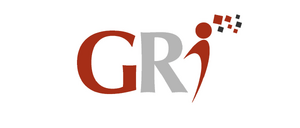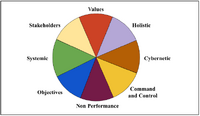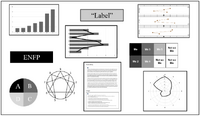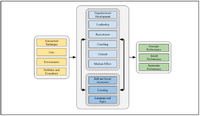Main Page: Difference between revisions
No edit summary |
|||
| Line 12: | Line 12: | ||
=[[Performance_Models | Performance]]= | =[[Performance_Models | Performance]]= | ||
[[File:Home_Performance.png|right|200px]] | [[File:Home_Performance.png|right|200px]] | ||
* What | * What organizational performance means. | ||
* Review of various performance approaches. | * Review of various performance approaches. | ||
* How performance and non-performance are assessed with adaptive profiles. | * How performance and non-performance are assessed with adaptive profiles. | ||
* Definition of an organization's strategic and social performance. | * Definition of an organization's strategic and social performance. | ||
* How to manage an organization's performance. | |||
=[[Assessment_Techniques | Assessment Techniques]]= | =[[Assessment_Techniques | Assessment Techniques]]= | ||
[[File:Assessment Techniques.png|right|200px]] | [[File:Assessment Techniques.png|right|200px]] | ||
* The nature and role of assessment techniques in organizations. | * The nature and role of assessment techniques in organizations. | ||
* Standards for comparing techniques redefined | * Standards for comparing techniques redefined. | ||
* Utility of assessment techniques redefined | * Utility of assessment techniques redefined. | ||
* Assessment techniques components under scrutiny | * Assessment techniques components under scrutiny. | ||
* What adaptive profiles tell. | * What adaptive profiles tell. | ||
| Line 28: | Line 29: | ||
[[File:Home_Individual Characteristics.png|right|200px]] | [[File:Home_Individual Characteristics.png|right|200px]] | ||
* Characteristics and how we assess them. | * Characteristics and how we assess them. | ||
* The big 7 | * Benefits of assessing some characteristics with techniques. | ||
* The many more characteristics we use | * The big 7 of personality. | ||
* Social performance, values, and intelligence detailed. | |||
* The many more characteristics we use for assessing people. | |||
=[[ Language_and_Signs | The Power of Signs]]= | =[[ Language_and_Signs | The Power of Signs]]= | ||
[[File:Home_The Power of Signs.png|right|200px]] | [[File:Home_The Power of Signs.png|right|200px]] | ||
* Understanding | * Understanding people and their organizations with signs. | ||
* | * Fundamentals of semiotics. | ||
* | * Symbols that are part of a broader picture. | ||
* Signs produced by Assessment Techniques. | |||
* Developing New Effective Meanings on Signs. | |||
=[[ General_Framework | GRI Framework]]= | =[[ General_Framework | GRI Framework]]= | ||
[[File:GRI Research Framework.png|right|200px]] | [[File:GRI Research Framework.png|right|200px]] | ||
* Framework initial steps and | * Framework initial steps and progress of the three steps. | ||
* Construction of the model. | |||
* Construction of the model. Theories behind the model. | * Theories behind the model. | ||
* Testing the framework, benchmarking techniques | * Antecedent, independent, and dependent variables. | ||
* Testing of the framework, benchmarking assessment techniques. | |||
Revision as of 07:02, 13 November 2025
Welcome to Growth Resources
The resources accessible from this page are shared by the Growth Resources Institute to help you continue to develop individual and organizational performance by deepening your understanding of the adaptive profiles and how they relate to other knowledge in our field.
The content is more theoretical and technical than practical. Using GRI's adaptive profiles and methods requires learning that starts with understanding your own profile and what you can do with it, most often in a business context with a leadership role. The experience provided by GRI's masterclass is central to learning and applying adaptive profiles in their many applications.
Like learning a new instrument, sport, or cooking, and even more so when learning about people, including their relationships and organizations, you'll need a minimum of time to practice in real situations and with people you think you already know well.
More than just learning, GRI offers you the opportunity to relearn much about people that seems immediate, obvious, but indeed will challenge your perceptions, intuition, and knowledge you already built and trust. Contact Growth Resources or one of its affiliates if you would like to learn GRI tools and methods.
Performance
- What organizational performance means.
- Review of various performance approaches.
- How performance and non-performance are assessed with adaptive profiles.
- Definition of an organization's strategic and social performance.
- How to manage an organization's performance.
Assessment Techniques
- The nature and role of assessment techniques in organizations.
- Standards for comparing techniques redefined.
- Utility of assessment techniques redefined.
- Assessment techniques components under scrutiny.
- What adaptive profiles tell.
Individual Characteristics
- Characteristics and how we assess them.
- Benefits of assessing some characteristics with techniques.
- The big 7 of personality.
- Social performance, values, and intelligence detailed.
- The many more characteristics we use for assessing people.
The Power of Signs
- Understanding people and their organizations with signs.
- Fundamentals of semiotics.
- Symbols that are part of a broader picture.
- Signs produced by Assessment Techniques.
- Developing New Effective Meanings on Signs.
GRI Framework
- Framework initial steps and progress of the three steps.
- Construction of the model.
- Theories behind the model.
- Antecedent, independent, and dependent variables.
- Testing of the framework, benchmarking assessment techniques.
Quick Links
Performance - Individual Characteristics and Assessment Techniques - Assessment Tools - Articles and Notes - Rowing Study W U25 2016
User's Guide on using the wiki. - Configuration settings - MediaWiki FAQ - MediaWiki release mailing list - Localise MediaWiki - Combat spam on the wiki -
About Growth Resources - Privacy policy - Copyright - Disclaimers






